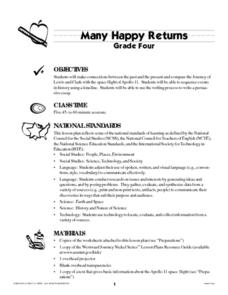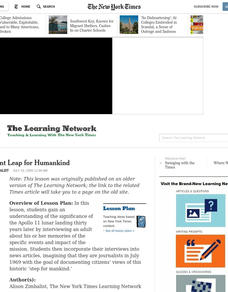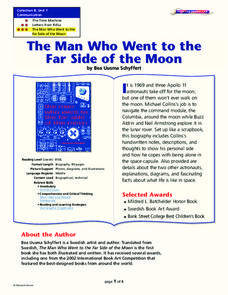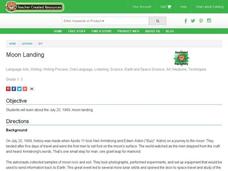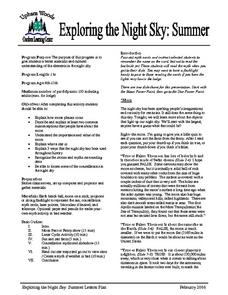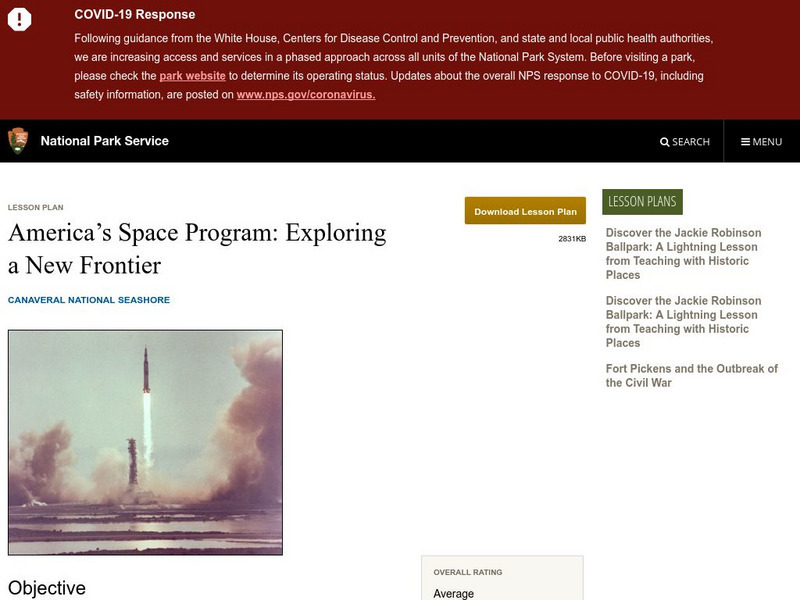Curated OER
Team Moon
Students read "Team Moon: How 400,000 People Landed Apollo 11 on the Moon," by Catherine Thimmesh. They watch portions of the movie "Apollo 13." Students use the internet and the attached study guide to discover specific information...
Curated OER
Activity on United States Moon Landing: Apollo 11
Students use the World Wide Web to access additional information needed to complete a set of questions. They demonstrate an understanding of latitude and longitude by interpreting a lunar map.
Curated OER
Many Happy Returns
Students compare the journey of Lewis and Clark with the space flight of Apollo 11. Students sequence events using a timeline. Students write a persuasive essay trying to persuade the people of the US to support space exploration.
Curated OER
Introduction of the Lunar Relief Map Project
Students investigate the geographic features of the surface of the moon. In this lunar relief map lesson plan, students watch and discuss the Apollo II Moon landing and make preliminary plans for their lunar maps.
Curated OER
"One Giant Leap for Mankind"
Students explore the significance of the Apollo 11 lunar landing by interviewing an adult for memories of the mission. They incorporate their interviews into news articles as 'journalists' in July 1969 to document this historic 'step for...
Curated OER
Globe Skills Lesson 10 Apollo 11
Students develop their globe skills. In this geography skills instructional activity, students use a globe and a softball to replicate distance between the earth and its moon.
Curated OER
Space Exploration
Sixth graders investigate the historical even surrounding the Apollo Mission to the Moon. They conduct research specifically to find information about the astronauts on the mission. The students conduct class discussion about the...
Curated OER
The Space Race in the '50's
Students explore the impact of the space race. In this 1950's America lesson, students examine newspapers from the time period as well as Apollo mission episodes. Students then create journals from the perspectives of Apollo astronauts.
University of Colorado
Distance = Rate x Time
Every year, the moon moves 3.8 cm farther from Earth. In the 11th part of 22, classes use the distance formula. They determine the distance to the moon based upon given data and then graph Galileo spacecraft data to determine its movement.
Curated OER
The Man Who Went to the Far Side of the Moon
Practice comprehension skills using the story, The Man Who Went to the Far Side of the Moon by Bea Uusma Schyffert. Learners answer questions, fill out graphic organizers, and engage in extension activities involving writing and...
Curated OER
Words in the News Solar Sail
Bring current events into your classroom! Middle schoolers complete word work activities before reading and discussing an online article. They complete worksheets and an online quiz. They discuss the Solar Sail as radical new idea and...
Curated OER
Importance of American Flag in American Literature
Betsy Ross - fact and myth. As an introduction to American Literature, class members become detectives and search web sites to find information about the flag, prominent places it has been displayed (on the moon, at ground zero, in...
Curated OER
Life on the Moon
Students study the physical properties of the Moon. In this life on the moon lesson students describe the ways life on the Moon would be different than on Earth.
Curated OER
The Mass of the Moon
In this mass of the Moon worksheet, learners use the lunar orbit and the orbit period to determine the mass of the Moon. They solve 4 problems including finding the mass of the Moon, determining the ratio of the Moon's mass to the...
Curated OER
Flight of the Future/Space Flight
Students explore space science by viewing videos on YouTube. In this moon landing lesson, students view clips of Neil Armstrong taking his first step on the moon and discuss the space race between the U.S. and Russia. Students utilize...
Curated OER
The Impact
Students study inventions and how they have impacted us. In this investigative lesson students study the history of two inventors then pretend that they are an inventor.
Curated OER
Moon Mining
Go on a moon mining expedition from the safety of your classroom with this space exploration simulation. Using simple models of the moon's surface prepared ahead of time by the teacher, young scientists are challenged with locating and...
Curated OER
Moon Landing
Students research about the July 20, 1969, moon landing. They demonstrate their knowledge of the first moon landing by creating peek-a-boo rocket books. Also they can make their own moon rocks with an easy-to-make dough.
Curated OER
Exploring the Night Sky: Summer
Learners explain how moon phases occur. They describe and explain at least two common misconceptions that people have about the moon. Students explain what a star is. They explain 3 ways that the night sky has been used throughout history.
Curated OER
Letters to the Man in the Moon
Young scholars write and communicate mathematically with their classmates. They discuss the mathematics that it took to allow us to conquer space and land on the moon. They sketch a plaque they would leave on the moon.
Curated OER
Astronomy: Earth/Moon
Students investigate the Earth and the Moon. They select activities from a menu of options including viewing videos, drawing magnetic fields and plate tectonics, creating vocabulary flashcards, observing the phases of the moon over a...
Curated OER
National Park Service: America's Space Program Exploring a New Frontier
This site includes a instructional activity for teachers to use when teaching about America's space program. Also included is the history of the space program, maps, readings, images of the space program, and benefits that resulted from...
Other popular searches
- Apollo 11 Mission
- Elementary Lessons Apollo 11
- Moon: Apollo 11
- Space Apollo 11
- Apollo 11 Conspiracy
- Timeline Apollo 11
- Apollo 11 Astronauts
- Time Line Apollo 11
- Apollo 11 Conspircacy
- Moon Apollo 11
- Apollo 11 Space Mission


